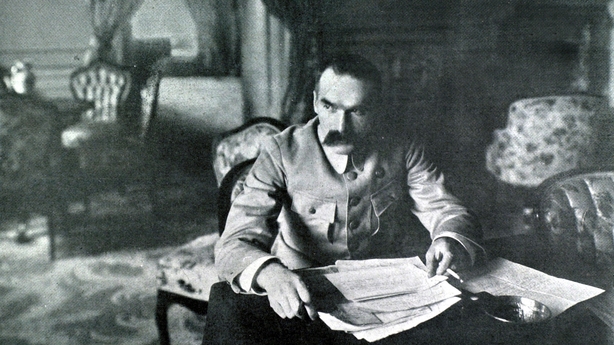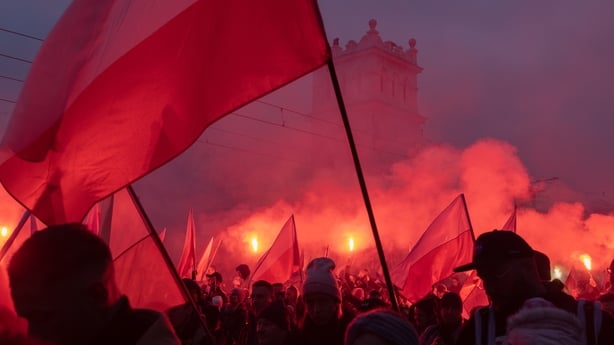Today marks Polish Independence Day, which is celebrated on 11 November each year.
It is a public holiday in Poland, with wreath-laying ceremonies and military processions being held across the country.
The fact that the occasion shares the same date as Armistice Day is no coincidence.
When the guns of the great powers fell silent on 11 November 1918 ending World War I, Poland re-emerged on the map of Europe after 123 years of partition and occupation by its neighbours.
In the late 18th century, one by one, Prussia, Austria-Hungary and Imperial Russia carved up Poland, dividing it into three.
With the surrender of Germany and Austria-Hungary in November 1918, and Russia already out of the war, Jozef Pilsudski, a Polish general, assumed control of the country and formed a new independent government.
"It's the great date in our history because this unification was almost politically impossible," Pawel Skibinski, a historian and author of the book 'Poland, 1918’, told RTÉ News.
Battles would rage for the next three years to secure the borders of the new country, including the decisive Battle of Warsaw in 1920 when the Polish army defeated a large Soviet force at the gates of the Polish capital.

The state that was reconstituted in 1918, the Polish Second Republic, was very different to the Poland of today.
For one, it encompassed land that today makes up western Ukraine, Belarus and Lithuania.
It included the cities of Lviv and Vilnius, both majority Polish-speaking at the time.
The country was also ethnically diverse, with sizeable minority groups.
Ukrainians accounted for about 14% of the population, 8% were Polish Jews, while Germans and Belarusians each made up about 4%. Lithuanians too accounted for a small minority.
General Pilsudski believed that Poland should be a pluralistic state, said Mr Skibinski, and wanted to create a regional power that could stand up to Russia and Germany.
The Second Republic lasted only 21 years, cut short by Nazi Germany’s invasion in 1939, which led to World War II.
In fact, Polish Independence Day was only celebrated twice on 11 November before the start of the war, in 1937 and 1938, according to Polish historian Andrzej Chwalba.
In the aftermath of World War II, Communist authorities banned 11 November as a day of commemoration, lest it awake calls for a democratic and independent Poland.
During the 1980s, members of Solidarity, the trade union which rallied against Communist rule, held unofficial marches in cities on 11 November.
It was only when the Polish Third Republic came into existence after free elections in 1989, that the country's Independence Day was restored to 11 November, becoming a public holiday again.
For the past decade and more, a collection of far-right groups, including members of the ultra-nationalist National Radical Camp (ONR), have used the date to stage a large nationalist march in Warsaw.
Their supporters light red flares in the middle of city and thousands of people march across one of the city's main bridges in a scene that looks like an inferno.
People travel from across the country to attend the march in the capital, many carrying nationalist banners.
The event has turned violent over the years, with participants often clashing with police.
In 2013, a large rainbow art installation, representing LGBTQ rights, was burnt down by far-right participants.
And again, in 2020, far-right protestors threw flares at an apartment building displaying an LGBTQ flag, setting one of the apartments alight.

Last year, anti-fascist groups, staged a counter-march close to the main gathering by ultra-nationalists and flew LGBTQ flags.
Symbolically, the march sets off from Dmowski roundabout in central Warsaw, named after Roman Dmowski, a right-wing politician during the Polish Second Republic.
Unlike Pilsudski, Dmowski was not a firm believer in a pluralistic Poland and in recent years ultra-nationalists have marched on 11 November with banners displaying his portrait.
"There are a few factions of the far-right and they are very often fighting with each other," Marcin Zaborowski, a political analyst, told RTÉ News.
The spectacle of thousands of flare-waving, far-right supporters taking over central Warsaw tends to grab the headlines, but it is only a "marginal aspect" of the day's events across the country, said Mr Zaborowski, policy director at GLOBESEC, a foreign policy think tank.
For decades, Poland has been one of Europe’s most homogenous countries.
But the country is becoming more ethnically diverse, though not to the same degree as the inter-war years.
Between 1 million and 1.5 million Ukrainian nationals currently reside in Poland, accounting for about 3% of the population.
The number of work visas issued to non-EU foreign nationals has increased each year since 2015 when the nationalist-populist Law and Justice party came to power.
Poland’s parliament will meet for the first time on Monday since a high-stakes general election last month.
The current Prime Minister Mateusz Morawiecki was nominated earlier this week by Polish President Andrzej Duda to form a new government.
Mr Morawiecki is highly unlikely to win a vote of confidence and form another Law and Justice government.
The centrist and left-wing opposition bloc, led by former Prime Minister Donald Tusk holds a majority of seats in parliament – 248 out of 460 seats – and is waiting for its chance to form a government, most likely in early December.
Law and Justice held its own Independence Day event in Warsaw yesterday evening to coincide with the actual date, 10 November, that General Pilsudski returned to Poland from captivity in Germany in 1918.







